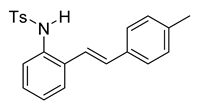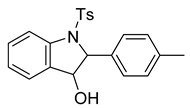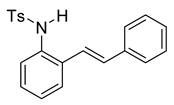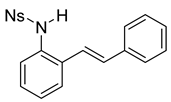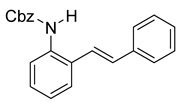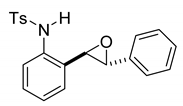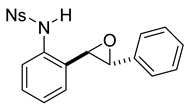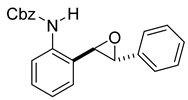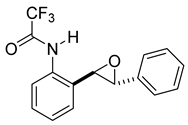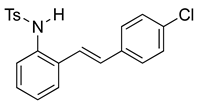An Operationally Simple Approach to Indole Derivatives from 2-Alkenylanilines Utilizing an Oxidation–Intramolecular Cyclization–Elimination Sequence
Abstract
:1. Introduction
2. Discussion
3. Materials and Methods
- (E)-1-(4-methylstyryl)-2-nitrobenzene (3): A procedure created by Nomura et al. was adapted for our synthesis [15]. To a 50 mL round-bottom flask containing (2-nitrobenzyl)triphenylphosphonium bromide (1.89 g, 3.94 mmol), we added DMSO (12 mL) and K2CO3 (7.88 mmol, 1.09 g). This mixture was allowed to stir for 2 h. 4-Tolualdehyde (3.94 mmol, 464 uL) was then added to the stirred mixture via syringe. This mixture was allowed to stir for 18 h. TLC (10% Et2O in Hex) indicated complete consumption of the aldehyde. Two spots appeared above the baseline, which are likely the E- and Z-isomers of the product. The purple mixture was poured into water (15 mL) and then extracted with ethyl acetate (3 × 20 mL) and then Et2O (2 × 15 mL). The combined organic layers were dried over MgSO4, filtered, and concentrated. The residue was purified via column chromatography (5.5% EtOAc in Hex). A set of fractions containing more polar E-isomers was isolated and concentrated to provide a yellow oil (460 mg, 1.92 mmol, 48.7%). 1H NMR(CDCl3, 400 MHz): δ (ppm) 7.93 (dd, J = 8.2, 1.3 Hz, 1H), 7.75 (dd, J = 7.8, 1.3 Hz, 1H), 7.62–7.56 (m, 2H), 7.53 (d, J = 16.3 Hz, 2H), 7.42 (d, J = 8.1 Hz, 2H), 7.40–7.34 (m, 2H), 7.17 (d, J = 7.9 Hz, 2H), 7.05 (d, J = 16.1 Hz, 1H), 2.36 (s, 3H). 13C NMR(CDCl3, 101 MHz): δ (ppm) 148.18, 138.92, 134.07, 133.95, 133.39, 133.19, 129.72, 128.23, 127.91, 127.23, 124.95, 122.59, 21.54.
- (E)-2-(4-methylstyryl)aniline (4). A 3-neck 50 mL round-bottom flask was charged with the nitrobenzene derivative (3, 220 mg, 0.92 mmol) and absolute ethanol (6.7 mL). The mixture was heated slightly to dissolve the nitrobenzene derivative. Iron powder (154 mg, 2.76 mmol) and ammonium chloride (50 mg, 0.92 mmol) were then added followed by water (1.8 mL). (A white precipitate formed upon the addition of water that gave way to a solution near the point of reflux.) The system was fitted with a reflux condenser and was then purged with nitrogen for 5 min. The mixture was then heated to reflux by a heating mantle for 1.5 h. TLC indicated the complete consumption of the starting material. After cooling, 15 mL of EtOH was added to the mixture and was heated slightly to dissolve the organic materials. The suspension was filtered through a pad of celite, and the filtrate was concentrated to provide a yellow solid. The solid was dissolved in 15 mL of EtOAc and washed with 10 mL of sat’d NaHCO3. The aqueous layer was further extracted with EtOAc (2 × 15 mL). The combined organic layers were dried over MgSO4, filtered, and concentrated to provide a dark yellow solid (169.5 mg, 0.81 mmol, 88%) that was used without further purification. 1H NMR(CDCl3, 400 MHz): δ (ppm) 7.45–7.34 (m, 3H), 7.17–7.05 (m, 4H), 6.95 (d, J = 16.0 Hz, 1H), 6.84 (td, J = 7.5, 1.1 Hz, 1H), 6.77 (dd, J = 7.9, 1.2 Hz, 1H), 4.35 (br. s, 1H), 2.34 (s, 3H). 13C NMR(CDCl3, 101 MHz): δ (ppm) 142.69, 137.73, 134.95, 130.85, 129.60, 128.66, 127.36, 126.62, 125.04, 123.18, 120.23, 117.11, 21.47.
- To a solution of 4 (611 mg, 2.91 mmol) and pyridine (0.70 mL, 8.76 mmol, 3.0 equiv) in DCM (12 mL, 0.25 M), we added p-toluenesulfonyl chloride (668 mg, 3.5 mmol, 1.2 equiv.) at 0 °C. The reaction was stirred in an ice bath while warming to room temperature for 12 h. The reaction mixture was quenched by the addition of a saturated aqueous solution of NH4Cl, and then, the product was extracted with DCM (3 × 10 mL). The combined organic phase was washed with brine, dried over Na2SO4, filtered, and concentrated under reduced pressure. The residue was purified via flash column chromatography on silica gel (20% EtOAc in hexanes) to afford a white solid (788 mg, 2.17 mmol, 74%). 1H NMR(CDCl3, 400 MHz): δ (ppm) 7.54 (d, J = 8.3 Hz, 2H), 7.35 (ddd, J = 32.3, 7.0, 2.6 Hz, 2H), 7.18–7.03 (m, 8H), 6.72–6.58 (m, 2H), 6.36 (s, 1H), 2.30 (s, 3H), 2.24 (s, 3H). 13C NMR(CDCl3, 101 MHz): δ (ppm) 143.92, 138.18, 136.60, 133.88, 133.20, 133.14, 132.40, 129.67, 129.37, 128.26, 127.16, 126.98, 126.61, 126.56, 126.50, 121.49, 21.50, 21.30.
- 2-(p-tolyl)-1-tosylindolin-3-ol (6). To a solution of the alkene (122 mg, 0.34 mmol) in dichloromethane (7 mL) under a stream of nitrogen, we added m-CPBA (70%, 165 mg, 0.67 mmol). The suspension was stirred at room temperature for 16 h. In the morning, the contents were poured into a flask containing 3 mL of NaHSO3 and 6 mL of NaHCO3. The biphasic solution was stirred vigorously for 10 min before pouring into a separatory funnel. The aqueous layer was extracted with dichloromethane (2 × 15 mL) and dried over Na2SO4. The solution was then filtered and concentrated to provide a solid residue. The residue was purified via silica gel flash chromatography (30% EtOAc in hexanes) to provide a white solid (96 mg, 0.25 mmol, 76%). 1H NMR(CDCl3, 400 MHz): δ (ppm) 7.75 (d, J = 8.2 Hz, 1H), 7.59–7.53 (m, 2H), 7.38–7.32 (m, 1H), 7.24–7.19 (m, 1H), 7.16–6.98 (m, 7H), 5.02 (d, J = 1.1 Hz, 1H), 4.67 (d, J = 1.2 Hz, 1H), 2.28 (s, 3H), 2.23 (s, 3H). 13C NMR(CDCl3, 101 MHz): δ (ppm) 144.25, 142.42, 137.67, 136.15, 134.63, 132.00, 130.84, 129.63, 129.41, 127.30, 126.23, 125.87, 124.93, 116.62, 79.05, 74.23, 21.56, 21.09.
- (E)-2-styrylaniline (9). To a solution of 2-iodoaniline (1.04 g, 4.8 mmol, 1.0 eq.) in triethylamine (4.8 mL, 1.0 M), Pd(OAc)2 (11 mg, 0.047 mmol, 1 mol%), P(o-Tol)3 (115 mg, 0.38 mmol, 8 mol%), and styrene (593 mg, 5.7 mmol, 1.2 eq.) were added. After being stirred at 100 °C for 20 h, the reaction mixture was cooled to room temperature, diluted with water and dichloromethane, and the phases were separated. The aqueous phase was extracted twice with dichloromethane (20 mL), and the combined organic phases were washed with brine (1 × 20 mL). The organic phases were dried over Na2SO4 and filtered. The filtrate was concentrated to afford the crude product. Purification by column chromatography on silica gel (12% EtOAc in hexanes) afforded a yellow solid (665.7 mg, 3.41 mmol, 72%). 1H NMR(CDCl3, 400 MHz): δ (ppm) 7.57–7.50 (m, 2H), 7.47 (dd, J = 7.7, 1.5 Hz, 1H), 7.38–7.32 (m, 2H), 7.28–7.23 (m, 2H), 7.15 (td, J = 7.6, 1.6 Hz, 1H), 7.03 (d, J = 16.0 Hz, 1H), 6.92 (td, J = 7.5, 1.2 Hz, 1H), 6.87 (dd, J = 7.9, 1.2 Hz, 1H), 5.08 (s, 1H). 13C NMR(CDCl3, 101 MHz): δ (ppm) 141.67, 137.45, 130.92, 128.67, 127.66, 127.23, 126.55, 125.12, 123.82, 120.62, 117.38.
- (E)-4-methyl-N-(2-styrylphenyl)benzenesulfonamide (10a). To a solution of 9 (0.45 g, 2.28 mmol, 1.0 equiv) and pyridine (0.55 mL, 6.8 mmol, 3.0 equiv) in DCM (23 mL, 0.25 M), we added p-toluenesulfonyl chloride (0.52 g, 2.7 mmol, 1.1 equiv.) at 0 °C. The reaction was stirred in an ice bath while warming to room temperature for 12 h. The reaction mixture was quenched by the addition of a saturated aqueous solution of NH4Cl, and then, the product was extracted with DCM (10 mL × 3). The combined organic phase was washed with brine, dried over Na2SO4, filtered, and concentrated under reduced pressure. The residue was purified via flash column chromatography on silica gel (20% EtOAc in hexanes) to afford a white solid (749.3 mg, 2.17 mmol, 95%). 1H NMR(CDCl3, 400 MHz): δ (ppm) 7.57–7.50 (m, 2H), 7.46–7.37 (m, 1H), 7.34–7.19 (m, 6H), 7.18–7.12 (m, 2H), 7.12–7.06 (m, 2H), 6.71 (s, 2H), 6.39 (s, 1H), 2.23 (s, 3H). 13C NMR(CDCl3, 101 MHz): δ (ppm) 143.95, 136.65, 136.57, 133.22, 133.17, 132.34, 129.68, 128.65, 128.45, 128.15, 127.17, 127.08, 126.72, 126.64, 122.60, 21.49.
- (E)-4-nitro-N-(2-styrylphenyl)benzenesulfonamide (10b). To a solution of 9 (0.165 g, 0.845 mmol, 1.0 equiv.) and pyridine (0.20 mL, 2.53 mmol, 3.0 equiv) in DCM (8.5 mL, 0.25 M), we added 4-nitrobenzenesulfonyl chloride (0.22 g, 1.01 mmol, 1.1 equiv) at 0 °C. The reaction was stirred in an ice bath while warming to room temperature for 12 h. The reaction mixture was quenched by the addition of a saturated aqueous solution of NH4Cl, and then, the product was extracted with DCM (10 mL × 3). The combined organic phase was washed with brine, dried over Na2SO4, filtered, and concentrated under reduced pressure. The residue was purified via flash column chromatography on silica gel (20% EtOAc in hexanes) to afford a yellow solid (268.7 mg, 0.71 mmol, 84%). 1H NMR(CDCl3, 400 MHz): δ (ppm) 8.18–8.13 (m, 2H), 7.90–7.86 (m, 2H), 7.56–7.51 (m, 1H), 7.41–7.31 (m, 6H), 7.28–7.24 (m, 2H), 6.76 (d, J = 3.0 Hz, 2H), 6.62 (s, 1H). 13C NMR(CDCl3, 101 MHz): δ (ppm) 150.10, 145.03, 136.19, 134.02, 132.78, 131.91, 128.85, 128.73, 128.58, 128.45, 128.26, 127.74, 126.85, 126.44, 124.18, 122.12.
- Benzyl (E)-(2-styrylphenyl)carbamate (10c). To a solution of 9 (0.24 g, 1.23 mmol, 1.0 equiv) and pyridine (0.30 mL, 3.7 mmol, 3.0 equiv) in DCM (4.1 mL, 0.25 M), we added benzyl chloroformate (0.21 mL, 1.5 mmol, 1.2 equiv) at 0 °C. The reaction was stirred in an ice bath while warming to room temperature for 12 h. The reaction mixture was quenched by the addition of a saturated aqueous solution of NH4Cl, and then, the product was extracted with DCM (3 × 10 mL). The combined organic phase was washed with brine, dried over Na2SO4, filtered, and concentrated under reduced pressure. The residue was purified via flash column chromatography on silica gel (20% EtOAc in hexanes) to afford an off-white solid (397 mg, 1.21 mmol, 98%).
- (E)-2,2,2-trifluoro-N-(2-styrylphenyl)acetamide (10d). To a solution of 9 (0.33 g, 1.70 mmol, 1.0 equiv) and pyridine (0.41 mL, 5.1 mmol, 3.0 equiv) in DCM (5.7 mL, 0.25 M), we added TFAA (0.28 mL, 1.2 equiv) at 0 °C. The reaction was stirred in an ice bath while warming to room temperature for 12 h. The reaction mixture was quenched by the addition of a saturated aqueous solution of NH4Cl, and then, the product was extracted with DCM (3 × 10 mL). The combined organic phase was washed with brine, dried over Na2SO4, filtered, and concentrated under reduced pressure to afford a white solid that was used without further purification (450.5 mg, 1.55 mmol, 91%). 1H NMR(CDCl3, 400 MHz): δ (ppm) 7.86 (s, 1H), 7.79 (dd, J = 8.0, 1.5 Hz, 1H), 7.52 (dd, J = 7.6, 1.7 Hz, 1H), 7.46–7.41 (m, 2H), 7.36–7.21 (m, 5H), 7.06–6.92 (m, 2H). 13C NMR(CDCl3, 101 MHz): δ (ppm) 155.13 (q, J = 36.8 Hz), 136.38, 134.25, 131.63, 130.87, 128.92, 128.61, 128.57, 127.54, 127.30, 126.74, 123.78, 121.93, 115.13 (q, J = 288.2 Hz).
- rac-4-methyl-N-(2-(3-phenyloxiran-2-yl)phenyl)benzenesulfonamide (11a). To a solution of 10a (175 mg, 0.5 mmol) in dichloromethane (10 mL), we added NaHCO3 (84 mg, 1.0 mmol.). The solution was stirred under a stream of nitrogen followed by the addition of mCPBA (70–75%, 247 mg, 1.0 mmol.). The reaction was allowed to stir for 3 h. TLC (20% EA in hexanes) indicated complete conversion. The reaction was quenched by the addition of 10 mL of a sat’d NaHCO3 solution followed by 10 mL of a sat’d NaHSO3 solution. This suspension was allowed to stir for 5 min before being poured into a separatory funnel, extracted with dichloromethane (3 × 10 mL), dried over Na2SO4, and concentrated to give an off-white solid that was used without further purification (179.9 mg, 0.49 mmol, 98%). A small sample of this crude material was analyzed with NMR to determine if epoxide was formed. 1H NMR(CDCl3, 400 MHz): δ (ppm) 7.64 (s, 1H), 7.62–7.55 (m, 2H), 7.37–7.27 (m, 4H), 7.18–7.04 (m, 7H), 3.68 (d, J = 2.1 Hz, 1H), 3.65 (d, J = 2.2 Hz, 1H), 2.33 (s, 3H). 13C NMR(CDCl3, 101 MHz): δ (ppm) 143.90, 136.58, 135.79, 135.14, 129.70, 128.94, 128.74, 128.67, 127.82, 127.55, 127.25, 125.57, 123.68, 62.06, 60.64, 21.59.
- rac-4-nitro-N-(2-(3-phenyloxiran-2-yl)phenyl)benzenesulfonamide (11b). To a solution of 10b (186 mg, 0.49 mmol) in dichloromethane (10 mL), we added NaHCO3 (82 mg, 0.98 mmol). The solution was stirred under a stream of nitrogen followed by the addition of mCPBA (70–75%, 241 mg). The reaction was allowed to stir for 3 h. TLC (20% EA in hexanes) indicated complete conversion. The reaction was quenched by the addition of 10 mL of a sat’d NaHCO3 solution followed by 10 mL of a sat’d NaHSO3 solution. This suspension was allowed to stir for 5 min before being poured into a separatory funnel, extracted with dichloromethane (3 × 10 mL), dried over Na2SO4, and concentrated. The crude yellow solid was used in the next step without any further purification.
- rac-benzyl (2-((2R,3R)-3-phenyloxiran-2-yl)phenyl)carbamate (11c). To a solution of 10c (114 mg, 0.34 mmol) in dichloromethane (7 mL), we added NaHCO3 (58 mg, 0.69 mmol.). The solution was stirred under a stream of nitrogen followed by the addition of mCPBA (70–75%, 170 mg, 0.69 mmol.). The reaction was allowed to stir for 18 h. TLC (10% EA in hexanes) indicated complete conversion. The reaction was quenched by the addition of 10 mL of a sat’d NaHCO3 solution followed by 10 mL of a sat’d NaHSO3 solution. This suspension was allowed to stir for 5 min before being poured into a separatory funnel, extracted with dichloromethane (3 × 10 mL), dried over Na2SO4, and concentrated to provide an off-white solid that was used without further purification (114 mg, 0.33 mmol, 96%). A small sample of this crude material was analyzed with NMR to determine if epoxide was formed. 1H NMR(CDCl3, 400 MHz): δ (ppm) 7.97–7.73 (m, 2H), 7.35–7.19 (m, 11H), 7.03 (td, J = 7.5, 1.2 Hz, 1H), 5.14–5.04 (m, 2H), 4.00 (d, J = 2.2 Hz, 1H), 3.91 (d, J = 2.1 Hz, 1H). 13C NMR(CDCl3, 101 MHz): δ (ppm) 153.77, 136.40, 136.20, 136.11, 128.98, 128.69, 128.63, 128.60, 128.58, 128.34, 128.31, 128.29, 127.53, 125.59, 67.03, 62.72, 60.15.
- rac-2,2,2-trifluoro-N-(2-(3-phenyloxiran-2-yl)phenyl)acetamide (11d). To a solution of 10d (322 mg, 1.1 mmol) in dichloromethane (22 mL), we added NaHCO3 (186 mg, 2.2 mmol.). The solution was stirred under a stream of nitrogen followed by the addition of mCPBA (70–75%, 545 mg, 2.2 mmol.). The reaction was allowed to stir for 18 h. TLC (10% EA in hexanes) indicated complete conversion. The reaction was quenched by the addition of 20 mL of a sat’d NaHCO3 solution followed by 20 mL of a sat’d NaHSO3 solution. This suspension was allowed to stir for 5 min before being poured into a separatory funnel, extracted with dichloromethane (3 × 10 mL), dried over Na2SO4, and concentrated to provide a gum that was used without further purification (1.1 mmol, 343 mg, quantitative). A small sample of this crude material was analyzed with NMR to determine if epoxide was formed. 1H NMR(CDCl3, 400 MHz): δ (ppm) 10.21 (s, 1H), 8.24 (dd, J = 8.3, 1.1 Hz, 1H), 7.39–7.23 (m, 7H), 7.15 (td, J = 7.6, 1.2 Hz, 1H), 4.08 (d, J = 2.3 Hz, 1H), 4.03 (d, J = 2.2 Hz, 1H). 13C NMR(CDCl3, 101 MHz): δ (ppm) 154.93 (q, J = 40.0 Hz), 135.10, 134.23, 129.28, 129.06, 128.84, 128.62, 125.74, 125.58, 124.15, 121.97, 115.82 (q, J = 292.7 Hz), 64.11, 60.28.
- 2-phenyl-1-tosyl-1H-indole (12a). To a stirred solution of 11a (in DCM (1.0 mL), we added TFA (0.1 mL). The solution immediately changed into a darker color. TLC (20% EtOAc in hexanes) indicated the complete conversion of the crude epoxide into indole. The solution was poured into 10 mL of sat’d NaHCO3 followed by the addition of 10 mL of DCM. The layers were poured into a separatory funnel. The organic layer was collected, and the aqueous layer was extracted with DCM (2 × 15 mL). The combined organic layers were dried over Na2SO4, filtered, and concentrated to provide a light yellow solid. 1H NMR(CDCl3, 400 MHz): δ (ppm) 8.24 (dd, J = 8.4, 0.9 Hz, 1H), 7.44–7.40 (m, 2H), 7.39–7.33 (m, 4H), 7.28 (ddd, J = 8.5, 7.3, 1.4 Hz, 2H), 7.21–7.18 (m, 3H), 6.99–6.92 (m, 2H), 6.47 (d, J = 0.8 Hz, 1H), 2.21 (s, 3H). 13C NMR(CDCl3, 101 MHz): δ (ppm) 144.52, 142.13, 138.27, 134.66, 132.42, 130.55, 130.33, 129.20, 128.65, 127.50, 126.80, 124.78, 124.30, 120.68, 116.66, 113.62, 21.53.
- 1-((4-nitrophenyl)sulfonyl)-2-phenyl-1H-indole (12b) [To a stirred solution of 11b (193 mg, 0.49 mmol) in DCM (10 mL), we added TFA (1 mL). The solution immediately changed into a darker color. After 18 h, TLC (20% EtOAc in hexanes) indicated the partial conversion of the crude epoxide into indole. The solution was poured into 10 mL of sat’d NaHCO3 followed by the addition of 10 mL of DCM. The layers were poured into a separatory funnel. The organic layer was collected, and the aqueous layer was extracted with DCM (2 × 15 mL). The combined organic layers were dried over Na2SO4, filtered, and concentrated to provide a dark yellow oil. This residue was purified via column chromatography (20% EtOAc in hexanes) to provide a yellow solid (87 mg, 0.23 mmol, 48%). 1H NMR(CDCl3, 400 MHz): δ (ppm) 8.22 (dq, J = 8.4, 0.9 Hz, 1H), 8.04–8.00 (m, 2H), 7.48–7.37 (m, 8H), 7.33 (ddd, J = 8.5, 7.3, 1.4 Hz, 1H), 7.24 (td, J = 7.5, 1.0 Hz, 1H), 6.53 (d, J = 0.8 Hz, 1H). 13C NMR(CDCl3, 101 MHz): δ (ppm) 150.44, 142.27, 141.94, 138.08, 131.72, 130.77, 130.18, 129.12, 128.09, 127.82, 125.44, 125.20, 123.79, 121.17, 116.72, 114.79.
- (E)-N-(2-(4-methoxystyryl)phenyl)benzenesulfonamide (10e). To a solution of 2-iodoaniline (1.00 g, 4.58 mmol, 1.0 eq.) in triethylamine (4.6 mL, 1.0 M), Pd(OAc)2 (10.2 mg, 0.046 mmol, 1 mol%), P(o-Tol)3 (111 mg, 0.36 mmol, 8 mol%), and 4-methoxystyrene (735 mg, 5.48 mmol, 1.2 eq.) were added. After being stirred at 100 °C for 20 h, the reaction mixture was cooled to room temperature, diluted with water and dichloromethane, and the phases were separated. The aqueous phase was extracted twice with dichloromethane (20 mL), and the combined organic phases were washed with brine (1 × 20 mL). The organic phases were dried over Na2SO4 and filtered. The filtrate was concentrated to afford the crude product. Purification via column chromatography on silica gel (12% EtOAc in hexanes) afforded a white solid (733 mg, 3.25 mmol, 71%). NMR spectra were consistent with data reported in the literature [7]. To a solution of this styrylaniline (370 mg, 1.64 mmol) and pyridine (3.0 equiv) in DCM (0.25 M), we added p-toluenesulfonyl chloride (1.1 equiv, 1.97 mmol, 356 mg) at 0 °C. The reaction was stirred in an ice bath while warming to room temperature for 12 h. The reaction mixture was quenched by the addition of a saturated aqueous solution of NH4Cl, and then, the product was extracted with DCM (3 × 10 mL). The combined organic phase was washed with brine, dried over Na2SO4, filtered, and concentrated under reduced pressure. The residue was purified via flash column chromatography on silica gel (20% EtOAc in hexanes) to afford a white solid (453 mg, 1.19 mmol, 73%). NMR spectra were consistent with data reported in the literature [7].
- (E)-4-Methyl-N-(2-(4-methylstyryl)phenyl)benzenesulfonamide (10f). To a solution of 2-iodoaniline (1.00 g, 4.58 mmol, 1.0 eq.) in triethylamine (4.6 mL, 1.0 M), Pd(OAc)2 (10.3 mg, 0.046 mmol, 1 mol%), P(o-Tol)3 (111 mg, 0.37 mmol, 8 mol%), and 4-methylstyrene (762 mg, 5.5 mmol, 1.2 eq.) were added. After being stirred at 100 °C for 20 h, the reaction mixture was cooled to room temperature, diluted with water and dichloromethane, and the phases were separated. The aqueous phase was extracted twice with dichloromethane (20 mL), and the combined organic phases were washed with brine (1 × 20 mL). The organic phases were dried over Na2SO4 and filtered. The filtrate was concentrated to afford the crude product. Purification via column chromatography on silica gel (12% EtOAc in hexanes) afforded a white solid (627 mg, 3.00 mmol, 65%). NMR spectra were consistent with data reported in the literature [7]. To a solution of this styrylaniline (611 mg, 2.91 mmol) and pyridine (0.70 mL, 8.76 mmol, 3.0 equiv) in DCM (12 mL, 0.25 M), we added p-toluenesulfonyl chloride (668 mg, 3.5 mmol, 1.2 equiv.) at 0 °C. The reaction was stirred in an ice bath while warming to room temperature for 12 h. The reaction mixture was quenched by the addition of a saturated aqueous solution of NH4Cl, and then, the product was extracted with DCM (3 × 10 mL). The combined organic phase was washed with brine, dried over Na2SO4, filtered, and concentrated under reduced pressure. The residue was purified via flash column chromatography on silica gel (20% EtOAc in hexanes) to afford a white solid (788 mg, 2.17 mmol, 74%). 1H NMR(CDCl3, 400 MHz): δ (ppm) 7.54 (d, J = 8.3 Hz, 2H), 7.35 (ddd, J = 32.3, 7.0, 2.6 Hz, 2H), 7.18–7.03 (m, 8H), 6.72–6.58 (m, 2H), 6.36 (s, 1H), 2.30 (s, 3H), 2.24 (s, 3H). 13C NMR(CDCl3, 101 MHz): δ (ppm) 143.92, 138.18, 136.60, 133.88, 133.20, 133.14, 132.40, 129.67, 129.37, 128.26, 127.16, 126.98, 126.61, 126.56, 126.50, 121.49, 21.50, 21.30.
- (E)-N-(2-(4-chlorostyryl)phenyl)benzenesulfonamide (10g). To a solution of 2-iodoaniline (1.00 g, 4.58 mmol, 1.0 eq.) in triethylamine (4.6 mL, 1.0 M), Pd(OAc)2 (10.3 mg, 0.046 mmol, 1 mol%), P(o-Tol)3 (111 mg, 0.37 mmol, 8 mol%), and 4-chlorostyrene (760 mg, 5.5 mmol, 1.2 eq.) were added. After being stirred at 100 °C for 20 h, the reaction mixture was cooled to room temperature, diluted with water and dichloromethane, and the phases were separated. The aqueous phase was extracted twice with dichloromethane (20 mL), and the combined organic phases were washed with brine (1 × 20 mL). The organic phases were dried over Na2SO4 and filtered. The filtrate was concentrated to afford the crude product. Purification via column chromatography on silica gel (12% EtOAc in hexanes) afforded a white solid (817.5 mg, 3.56 mmol, 77%). NMR spectra were consistent with data reported in the literature [7]. To a solution of this styrylaniline (363 mg, 1.58 mmol) and pyridine (0.38 mL, 4.74 mmol, 3.0 equiv) in DCM (5.2 mL, 0.25 M), we added p-toluenesulfonyl chloride (362 mg, 1.9 mmol, 1.2 equiv) at 0 °C. The reaction was stirred in an ice bath while warming to room temperature for 12 h. The reaction mixture was quenched by the addition of a saturated aqueous solution of NH4Cl, and then, the product was extracted with DCM (10 mL × 3). The combined organic phase was washed with brine, dried over Na2SO4, filtered, and concentrated under reduced pressure. The residue was purified via flash column chromatography on silica gel (20% EtOAc in hexanes) to afford a white solid (532 mg, 1.39 mmol, 88%). NMR spectra were consistent with data reported in the literature [7].
- N-Ts-2-(4-methoxyphenyl)indole (12c). To a solution of 10e (127 mg, 0.33 mmol)) in DCM (7 mL), we added NaHCO3 (54 mg, 0.64 mmol, 2 equiv). The solution was stirred under a stream of nitrogen followed by the addition of mCPBA (70%, 154 mg, 0.62 mmol, 2 equiv.). The reaction was allowed to stir for 3 h. TLC (20% EA in hexanes) indicated complete conversion. The reaction was quenched by the addition of 10 mL of a sat’d NaHCO3 solution followed by 10 mL of a sat’d NaHSO3 solution. This suspension was allowed to stir for 5 min before being poured into a separatory funnel, extracted with DCM (3 × 10 mL), dried over Na2SO4, and concentrated. The residue was dissolved in DCM (6.6 mL) with stirring. To this stirred solution, we added TFA (~0.7 mL), which was followed by an immediate color change. TLC (20% EA in hexanes), which indicated the complete conversion of the crude epoxide into indole. The reaction was poured into a separatory funnel and washed twice with 10 mL of a sat’d NaHSO3 solution. The organic layer was dried over Na2SO4 and filtered. The filtrate was concentrated to afford a light yellow solid (99.1 mg, 0.26 mmol, 80%). NMR spectra were consistent with data reported in the literature [7].
- N-Ts-2-(4-methylphenyl)indole (12d). To a solution of 10f (45 mg, 0.13 mmol) in DCM (3 mL), we added NaHCO3 (21 mg, 0.28 mmol, 2 equiv.). The solution was stirred under a stream of nitrogen followed by the addition of mCPBA (70%, 62 mg, 0.28 mmol, 2 equiv.). The reaction was allowed to stir for 3 h. TLC (20% EA in hexanes) indicated complete conversion. The reaction was quenched by the addition of 10 mL of a sat’d NaHCO3 solution followed by 10 mL of a sat’d NaHSO3 solution. This suspension was allowed to stir for 5 min before being poured into a separatory funnel, extracted with DCM (3 × 10 mL), dried over Na2SO4, and concentrated. The residue was dissolved in DCM (2.6 mL) with stirring. To this stirred solution, we added TFA (~0.3 mL), which was followed by an immediate color change. TLC (20% EA in hexanes) indicated the complete conversion of the crude epoxide into indole. The reaction was poured into a separatory funnel and washed twice with 10 mL of a sat’d NaHSO3 solution. The organic layer was dried over Na2SO4 and filtered. The filtrate was concentrated to afford a light yellow solid (36 mg, 0.10 mmol, 78%). NMR spectra were consistent with data reported in the literature [7].
- N-Ts-2-(4-chlorophenyl)indole (12e). To a solution of 10g (149 mg, 0.39 mmol)) in DCM (8 mL), we added NaHCO3 (66 mg, 0.79 mmol, 2 equiv.). The solution was stirred under a stream of nitrogen followed by the addition of mCPBA (70%, 195 mg, 0.79 mmol, 2 equiv.). The reaction was allowed to stir for 3 h. TLC (20% EA in hexanes) indicated complete conversion. The reaction was quenched by the addition of 10 mL of a sat’d NaHCO3 solution followed by 10 mL of a sat’d NaHSO3 solution. This suspension was allowed to stir for 5 min before being poured into a separatory funnel, extracted with DCM (3 × 10 mL), dried over Na2SO4, and concentrated. The residue was dissolved in DCM (8 mL) with stirring. To this stirred solution, we added TFA (~0.8 mL), which was followed by an immediate color change. TLC (20% EA in hexanes) indicated the complete conversion of the crude epoxide into indole. The reaction was poured into a separatory funnel and washed twice with 10 mL of a sat’d NaHSO3 solution. The organic layer was dried over Na2SO4 and filtered. The filtrate was concentrated to afford a light yellow solid (34.6 mg, 0.30 mmol, 77%). NMR spectra were consistent with data reported in the literature [7].
4. Conclusions
Supplementary Materials
Author Contributions
Funding
Institutional Review Board Statement
Informed Consent Statement
Data Availability Statement
Conflicts of Interest
References
- Kaushik, N.K.; Kaushik, N.; Attri, P.; Kumar, N.; Kim, C.H.; Verma, A.K.; Choi, E.H. Biomedical Importance of Indoles. Molecules 2013, 18, 6620–6662. [Google Scholar] [CrossRef] [PubMed]
- Hegedus, L.S.; Allen, G.F.; Bozell, J.J.; Waterman, E.L. Palladium-Assisted Intramolecular Amination of Olefins. Synthesis of Nitrogen Heterocycles. J. Am. Chem. Soc. 1978, 100, 5800–5807. [Google Scholar] [CrossRef]
- Larock, R.C.; Hightower, T.R.; Hasvold, L.A.; Peterson, K.P. Palladium(II)-Catalyzed Cyclization of Olefinic Tosylamides. J. Org. Chem. 1996, 61, 3584–3585. [Google Scholar] [CrossRef] [PubMed]
- Maity, S.; Zheng, N. A Visible-Light-Mediated Oxidative C–N Bond Formation/Aromatization Cascade: Photocatalytic Preparation of N-Arylindoles. Angew. Chem. Int. Ed. 2012, 51, 9562–9566. [Google Scholar] [CrossRef] [PubMed]
- Youn, S.W.; Ko, T.Y.; Jang, M.J.; Jang, S.S. Silver(I)-Mediated C–H Amination of 2-Alkenylanilines: Unique Solvent-Dependent Migratory Aptitude. Adv. Synth. Catal. 2015, 357, 227–234. [Google Scholar] [CrossRef]
- Youn, S.W.; Jang, S.S.; Lee, S.R. Bi(OTf)3-Mediated Intramolecular Hydroamination of 2-Aminostilbenes for the Synthesis of 2-Arylindolines. Tetrahedron 2016, 72, 4902–4909. [Google Scholar] [CrossRef]
- Jang, Y.H.; Youn, S.W. Metal-Free C–H Amination for Indole Synthesis. Org. Lett. 2014, 16, 3720–3723. [Google Scholar] [CrossRef] [PubMed]
- Li, Y.; Li, J.; Ma, A.; Huang, Y.; Deng, J. Metal-Free Synthesis of Indole Via NIS-Mediated Cascade C–N Bond Formation/Aromatization. J. Org. Chem. 2015, 80, 3841–3851. [Google Scholar] [CrossRef] [PubMed]
- Ma, A.; Li, Y.; Li, J.; Deng, J. A Concise Approach to Indoles Via Oxidative C-H Amination of 2-Alkenylanilines using Dioxygen as the Sole Oxidant. RSC Adv. 2016, 6, 35764–35770. [Google Scholar] [CrossRef]
- Ortgies, S.; Breder, A. Selenium-Catalyzed Oxidative C(Sp2)–H Amination of Alkenes Exemplified in the Expedient Synthesis of (Aza-)Indoles. Org. Lett. 2015, 17, 2748–2751. [Google Scholar] [CrossRef] [PubMed]
- Zhang, X.; Guo, R.; Zhao, X. Organoselenium-Catalyzed Synthesis of Indoles through Intramolecular C-H Amination. Org. Chem. Front. 2015, 2, 1334–1337. [Google Scholar] [CrossRef]
- Yu, E.; Kim, H.; Park, C. Metal- and Oxidant-Free Electrosynthesis of Heterocycles from 1,2-Diarylalkene Derivatives. Adv. Synth. Catal. 2022, 364, 4088–4096. [Google Scholar] [CrossRef]
- Zhang, J.; Li, X.; Li, X.; Shi, H.; Sun, F.; Du, Y. DMSO/SOCl2-Mediated C(Sp2)–H Amination: Switchable Synthesis of 3-Unsubstituted Indole and 3-Methylthioindole Derivatives. Chem. Commun. 2021, 57, 460–463. [Google Scholar] [CrossRef] [PubMed]
- Monceaux, C.J.; Carlier, P.R. Regioselective Synthesis of Aniline-Derived 1,3- and Ci-Symmetric 1,4-Diols from Trans-1,4-Cyclohexadiene Dioxide. Org. Lett. 2010, 12, 620–623. [Google Scholar] [CrossRef] [PubMed]
- Nomura, S.; Endo-Umeda, K.; Aoyama, A.; Makishima, M.; Hashimoto, Y.; Ishikawa, M. Styrylphenylphthalimides as Novel Transrepression-Selective Liver X Receptor (LXR) Modulators. ACS Med. Chem. Lett. 2015, 6, 902–907. [Google Scholar] [CrossRef] [PubMed]
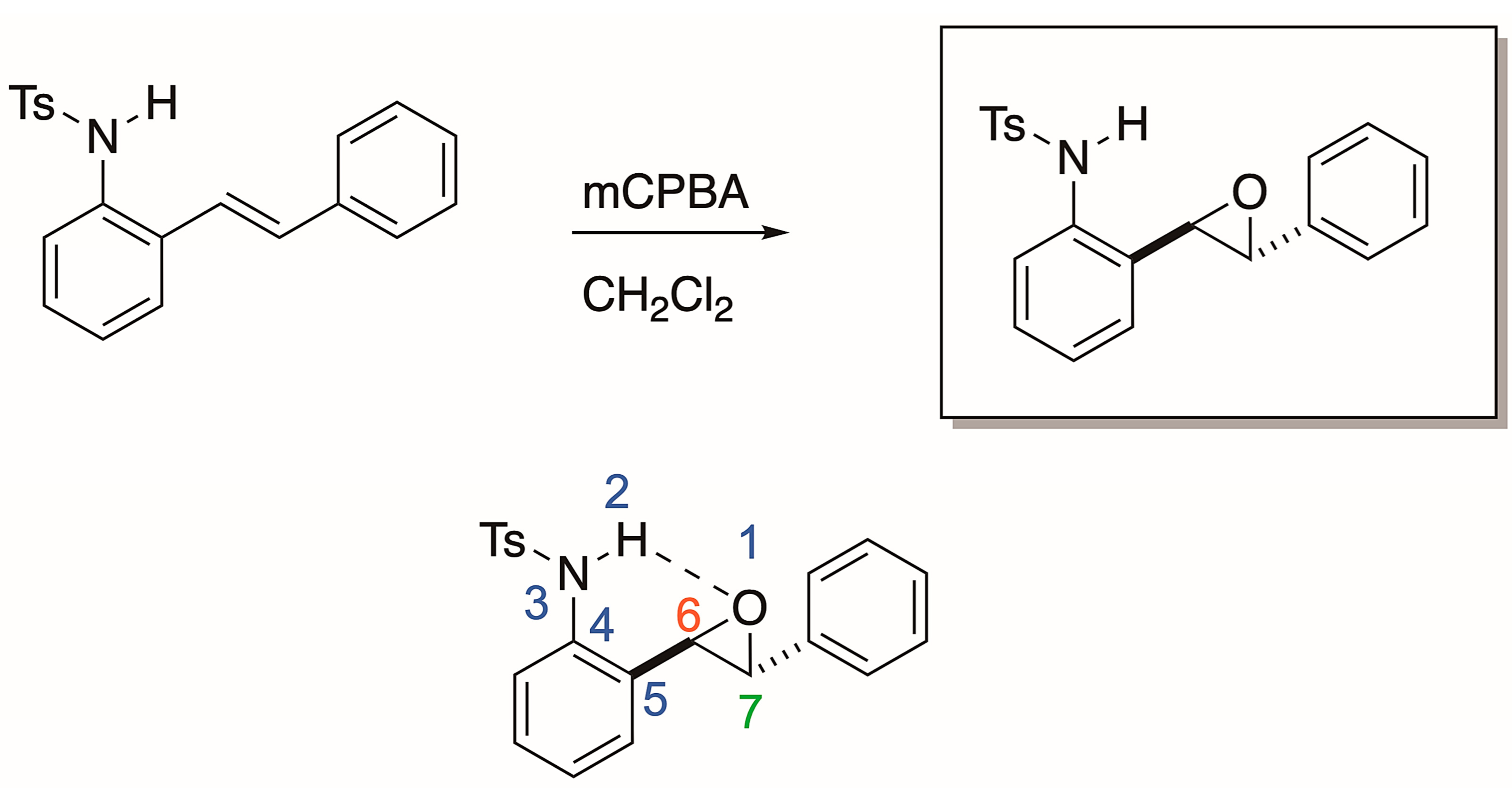
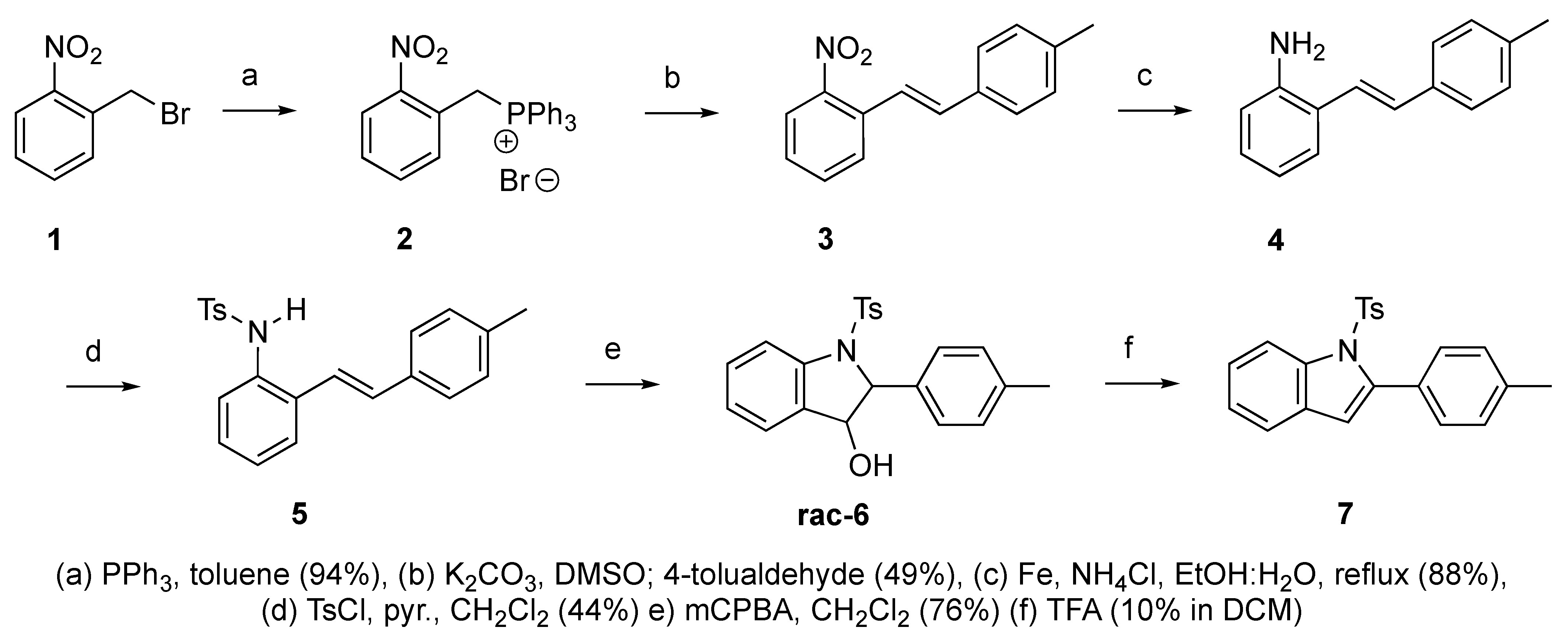
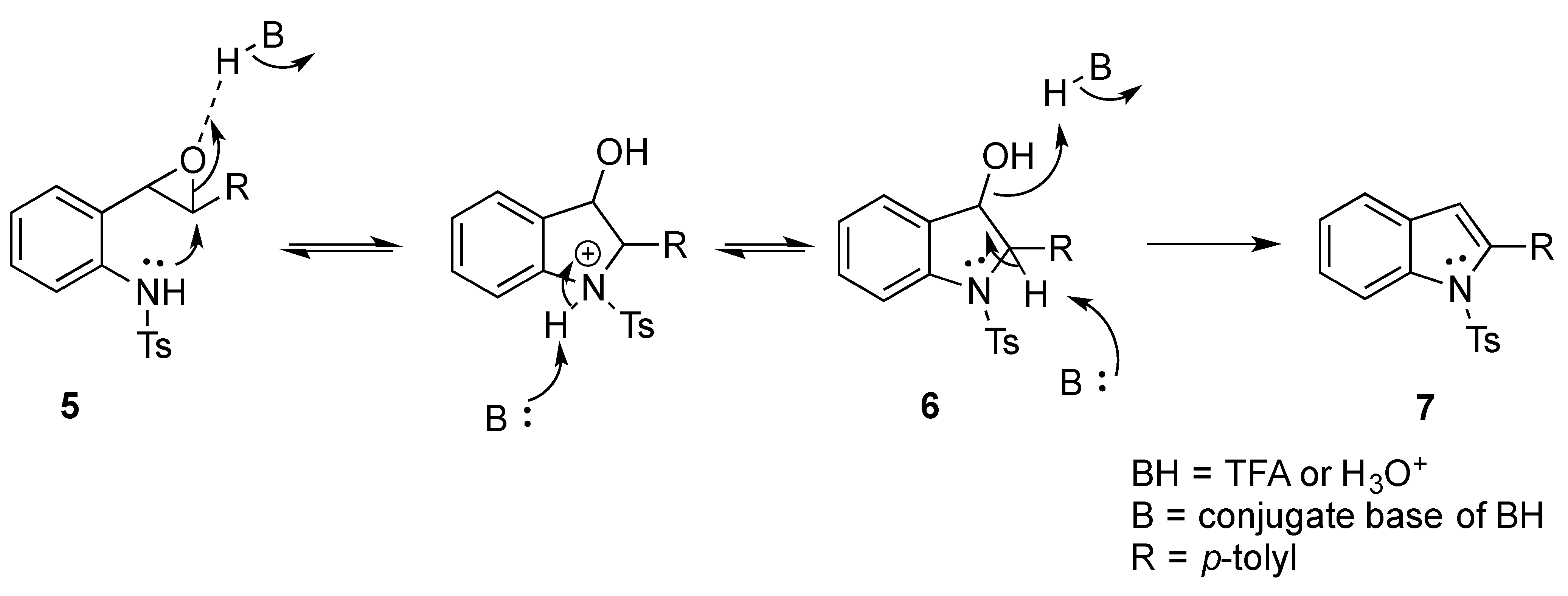

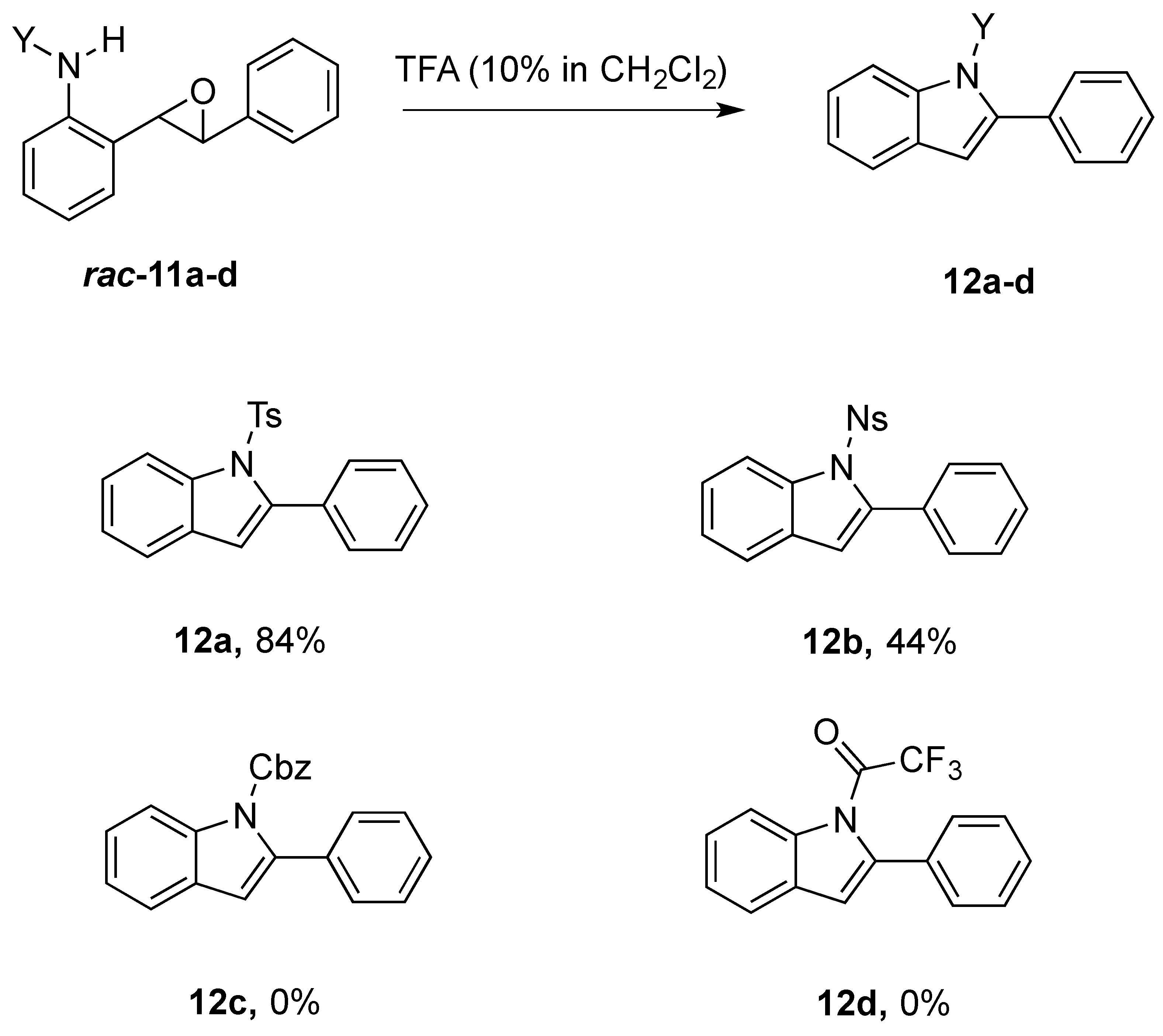
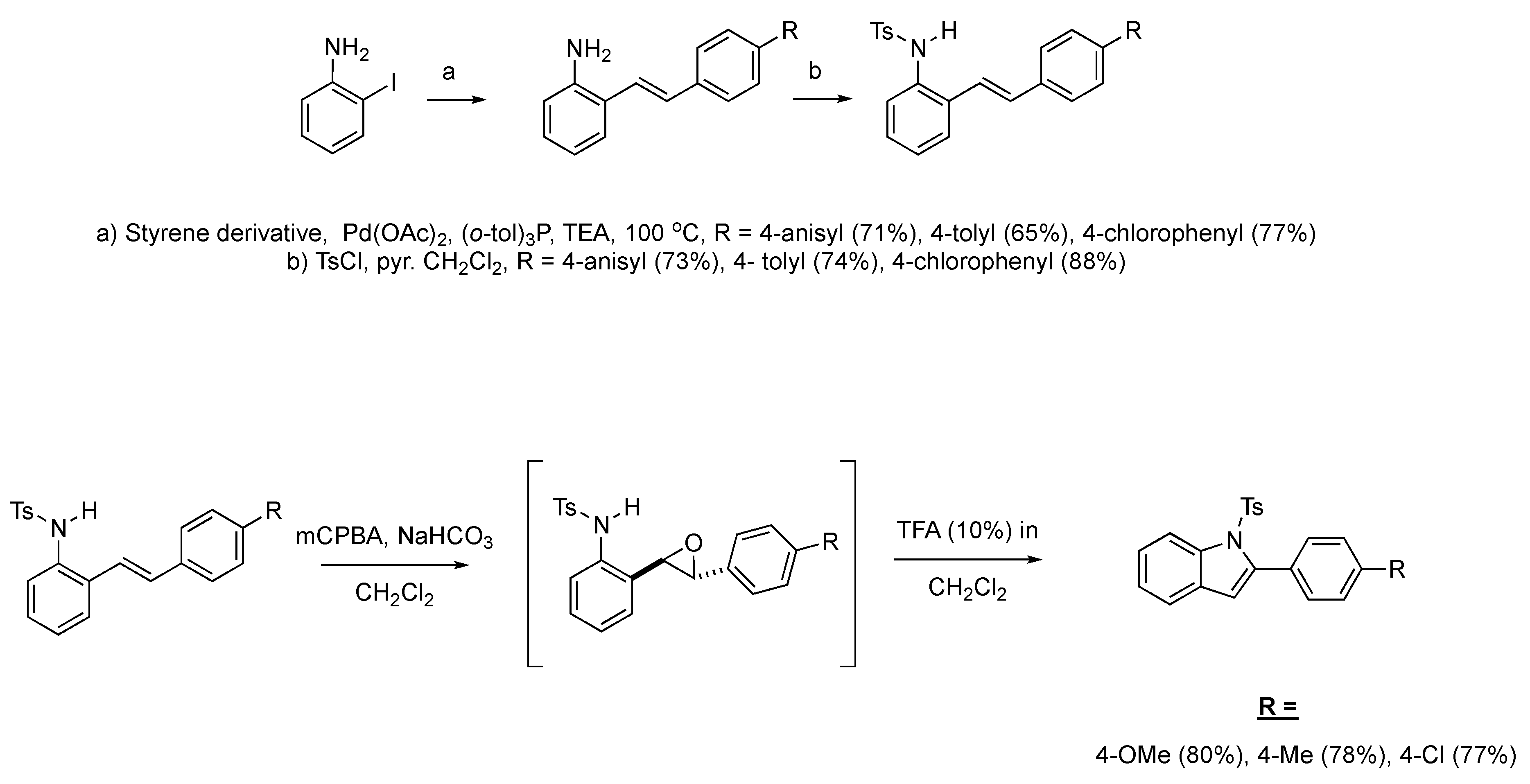
Disclaimer/Publisher’s Note: The statements, opinions and data contained in all publications are solely those of the individual author(s) and contributor(s) and not of MDPI and/or the editor(s). MDPI and/or the editor(s) disclaim responsibility for any injury to people or property resulting from any ideas, methods, instructions or products referred to in the content. |
© 2023 by the authors. Licensee MDPI, Basel, Switzerland. This article is an open access article distributed under the terms and conditions of the Creative Commons Attribution (CC BY) license (https://creativecommons.org/licenses/by/4.0/).
Share and Cite
Hines, L.N.; King, J.R.; Atwood, A.C.; Chapman, R.M.; Griffey, M.B.; Tutwiler, C.R.; Monceaux, C.J. An Operationally Simple Approach to Indole Derivatives from 2-Alkenylanilines Utilizing an Oxidation–Intramolecular Cyclization–Elimination Sequence. Molecules 2023, 28, 7968. https://doi.org/10.3390/molecules28247968
Hines LN, King JR, Atwood AC, Chapman RM, Griffey MB, Tutwiler CR, Monceaux CJ. An Operationally Simple Approach to Indole Derivatives from 2-Alkenylanilines Utilizing an Oxidation–Intramolecular Cyclization–Elimination Sequence. Molecules. 2023; 28(24):7968. https://doi.org/10.3390/molecules28247968
Chicago/Turabian StyleHines, Lauren N., Jacob R. King, Alex C. Atwood, Rachel M. Chapman, Matthew B. Griffey, Christine R. Tutwiler, and Christopher Jon Monceaux. 2023. "An Operationally Simple Approach to Indole Derivatives from 2-Alkenylanilines Utilizing an Oxidation–Intramolecular Cyclization–Elimination Sequence" Molecules 28, no. 24: 7968. https://doi.org/10.3390/molecules28247968





